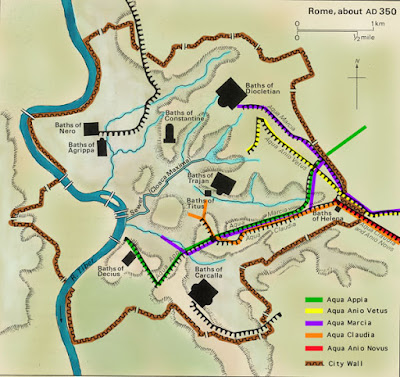 |
| Remains of a toilet house in Herculaneum, attached to the baths (Photo by Author) |
People’s body functions were no
different in antiquity than they are today, and toilets were just as important
then as they are now, despite many people’s wish to place the Roman’s on an
inhuman pedestal. In fact, toilets were extremely important to Romans, who in
about the first century BCE created a proliferation of public and private
toilets not seen before. They became a key player in Roman infrastructure and
served to help curb the human waste problems present in a city that large, and
keep the streets in a more respectable condition.
There
are two main types of toilets, public and private. Public toilets were often
large rooms that were lined with stone (or wooden) benches 43 cm high, a very
comfortable sitting height. These benches had round holes in the top, spaced 56cm
apart, with a keyhole shaped slit continuing on the front where a sponge tipped
stick could be inserted for cleaning (like our modern day toilet-paper, just
more environmentally friendly!). At the foot of the bench lay another shallow
channel that archaeologists suspect were used for cleaning these sticks to
provide some measure of sanitation. These bench holes would drop into a channel
to a maximum of 380 cm, where waste water from the baths (or just water in
general) would sweep away the refuse into the sewer. An intimate experience no doubt,
but something that would have been normal in Roman minds.
 |
| Close up of the trough at the feet of the toilet in Herculaneum (Photo by Author) |
The second
type of toilet is a private one. Located in the culina, or kitchen, they were simple – usually single person
toilets, used not only for bathroom needs, but also as a waste disposal for
food scraps. These toilets were not like the public toilets in that they
connected to the sewers (usually), but like modern day outhouses, that stood
upon pits to be piled up with waste, and then emptied when reaching a state of
filling. Human waste was actually considered a resource in Rome, and was sold
to farmers to be turned into field fertilizer, if it wasn’t used by the master
in his private gardens.
Bibliography
Wald, Chelsea. "The Secret History of Ancient Toilets." Nature 533, no. 7604 (2016): 456-
58. Accessed June 30, 2016. doi:10.1038/533456a.












